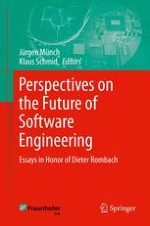2013 | OriginalPaper | Chapter
Challenges of Evaluating the Quality of Software Engineering Experiments
Authors : Oscar Dieste, Natalia Juristo
Published in: Perspectives on the Future of Software Engineering
Publisher: Springer Berlin Heidelberg
Activate our intelligent search to find suitable subject content or patents.
Select sections of text to find matching patents with Artificial Intelligence. powered by
Select sections of text to find additional relevant content using AI-assisted search. powered by
